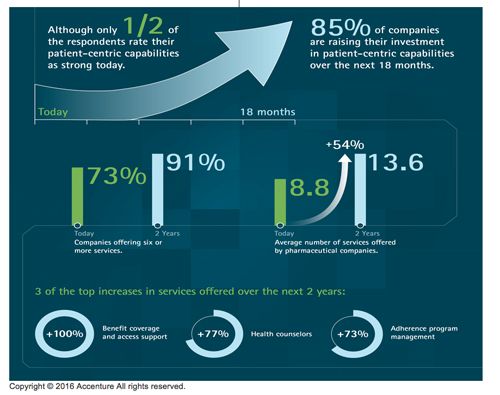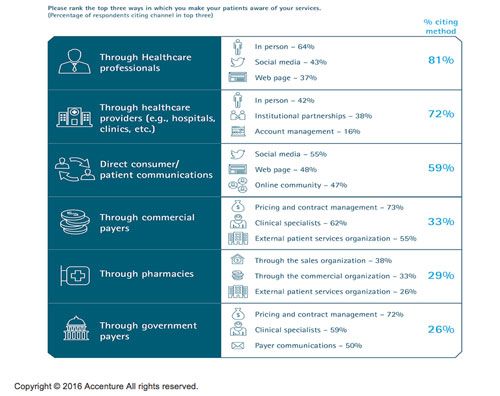Investing in Patient-Centric Capabilities Requires a Clear Strategy
For those willing to invest in the right capabilities, offering patient services can give pharma companies a tremendous opportunity.
Patient services â services that are designed to make a patient’s medical journey simpler and more effective â are no longer optional. Patients want better health outcomes, and offering patient services can give pharmaceutical companies a tremendous opportunity â for those willing to invest in the right capabilities and let the patient know about the services in the right way.
While patient services can deliver value, to do so and to be successful, patient services executives need to develop a clear patient-services strategy that fully meets the needs of patients, measures its own success, and shows healthcare professionals how such services can improve patients’ health outcomes. Recent research shows that 85 percent of respondents said their organizations plan to ramp-up their spending on patient-centric capabilities over the next two years.[i]
This is just one of the findings in new research titled “The Patient is IN: Pharma’s Growing Opportunity in Patient Services.” The research is based on a survey of more than 200 patient services executives at leading pharmaceutical companies in the US and Europe covering seven therapeutic areas that include the heart, lungs, brain, immune system, bones, hormone/metabolism, and cancer to understand where their companies are in developing patient services and where they intend to go over the next two years. The research further contrasts these finding with what patients indicating they want, value and expert from patient services.
While patients have consistently indicated that they want, and expect from patient services, the response show that the vast majority of patients aren’t aware of the services already available to them. Such services include treatment adherence programs, remote patient monitoring, and medication delivery and support.
Delivering impact
Nine of the top ten most prevalent services and service-related capabilities, offered today, including patient disease education and medication delivery and support, are driving above-average business impact, according to survey respondents. Segmenting patients into groups that share common traits and behaviors to better serve their specific needs, the second most prevalent service, leads the way in terms of delivering business impact.
Over the next 18 months, 85 percent of respondents said they are raising their investments in capabilities in patient services. And just about half (51 percent), of respondents report that their capabilities are strong today. However, respondents made little progress over the last two years in becoming more focused on patients.
Almost all of the companies surveyed (91 percent) expect to offer six or more patient services in
the next two years, up from 73 percent of those offering six or more today. The average number of patient services offered is expected to increase by more than 50 percent in two years. Some of the biggest increases will be in benefit coverage and access support, health counselors, and adherence program management.
Patient services are delivering value with a significant increase in focus and investment expected over the next two years

Emphasizing Digital and Analytics
With patients’ increasing access to a growing array of information relating to their health and care through their phones and other devices, 95 percent of companies plan to invest in patient engagement technologies in the next 18 months. Most (60 percent) are directing their largest investments toward technologies that interface with patients and healthcare professionals.
But analytics and reporting metric technologies are also a priority, along with patient data management technologies. Smart connected devices represent the fourth largest area of investment, with 41 percent of survey respondents indicating an intent to invest.
Digital channels are playing a dominant role in making patients aware of services. When companies communicate with patients through healthcare providers, digital channels command the second -- social media, 43 percent -- and third -- web pages, 37 percent -- means of engagement, after in-person communication, 64 percent. And when companies communicate directly with patients, all three top channels overall are digital: social media, 55 percent; web page, 48 percent; and online communities, 47 percent.
Digital channels play a dominant role in making patients aware of their services

These results vary slightly between respondents in the US and Europe. In the US, television is the top way in which pharmaceutical companies communicate directly with patients or consumers â 53 percent; with social media, 51 percent, and web pages, 48 percent, following. In Europe, social media, 59 percent; direct emails, 50 percent; and online communities, 48percent; are the top three ways of communicating.
Service maturation
Patient services are “growing up.” In the early days, companies offered simple services, such as
disease education and co-pay cards. In the last two years, companies have begun to invest in more innovative services, such as remote monitoring. As the field of patient services matures, pharmaceutical companies are seeking to invest in more innovative and technology-driven offerings.
But not all patient services are aligned to patients, the research finds. Of the top 10 patient services expected to grow the most extensively in the future, only half align with what patients currently value most. For some services, patient value greatly exceeds the company intent to expand those services.
For example, medication delivery/support is highly valued by 85 percent of patients, but offering those services is only expected to increase by 55 percent. Patient outreach, reminders, and scheduling services are highly valued by 79 percent of patients, but their offering is expected to expand by just 54 percent.
Obstacles encumbering success
The research shows that pharmaceutical companies are committed to increasing and improving their services. Yet, the survey found potential barriers, most specifically in terms of communication, measurement, and organization.
Communication: Perhaps the most striking challenge for pharmaceutical companies involves simply making patients aware that these services exist. Accenture’s 2015 worldwide survey of 10,000 patients revealed that less than one in five patients, 19 percent, are aware of available services.
Eighty-one percent of survey respondents go through healthcare professionals to make patients aware of their services, which is how patients prefer to hear about them. But most often, the professionals are either not relaying information about services to their patients, or are not doing so in a meaningful enough way for patients to remember them.
Measurement: Across the US and Europe, the main goal for investing in patient services is to improve patient outcomes. But fewer than half of respondents, 43 percent, reported that their companies can precisely measure the impact these services have on patient outcomes.
Organization: The challenge for pharmaceutical companies is that the ownership for patient services is often spread across organizations. Sixty-two percent of survey respondents identified themselves as a head of patient services or patient experience, however, 73 percent of respondents say that no single function has primary responsibility for patient services within their organization.
Specific strategies needed
As patient services are no longer optional, pharmaceutical companies must determine the types of patient services to offer, and how best to offer them. Companies should thoughtfully understand their patients’ needs and set their patient services strategy accordingly. However, the impact of their investments in patient services could be called into question if they can’t measure and prove patient and business value.
A clear organizational and operating strategy must be in place to ensure companies are structured for success. There must be clarity throughout the organization where ownership of the services and the strategy resides. Mixed ownership can create inefficiencies, limit innovation, and hinder a company’s ability to measure impact.
Most pharmaceutical companies are using healthcare professionals as the primary way to make patients aware of their services, but this approach has yet to be effective. Companies must frame their product conversations with healthcare professionals to include outcomes achievable through the combination of products and services. Professionals must view this bundled solution as integral to achieving better outcomes, and then will be more inclined to discuss these solutions with patients.
In the future, pharmaceutical companies will be increasingly assessed on their ability to create value at the population level and for healthcare systems overall. Companies must sharpen their ability to quantify results for patient value and internally for sustaining investments in patient services.
Pharmaceutical companies must expand and capture the impact of their services, and use this information to adapt what they provide, and differentiate themselves from competitors, going beyond only the therapeutic benefits of their drugs.
Click hereto view an infographic illustrating this research.
About the Author
Andrea Brückner is a managing director in Accenture’s Life Sciences practice. She also leads the practice in Europe, Africa and Latin America as well as in Germany, Austria and Switzerland. She has over 12 years consulting experience in the United States and Europe.
[i] Pharmaceutical Companies to Accelerate Investment in Patient-Centric Capabilities and Services Over Next Two Years, According to Accenture Report. Cam Granstra. April 12, 2016. https://newsroom.accenture.com/news/pharmaceutical-companies-to-accelerate-investment-in-patient-centric-capabilities-and-services-over-next-two-years-according-to-accenture-report.htm.
Addressing Disparities in Psoriasis Trials: Takeda's Strategies for Inclusivity in Clinical Research
April 14th 2025LaShell Robinson, Head of Global Feasibility and Trial Equity at Takeda, speaks about the company's strategies to engage patients in underrepresented populations in its phase III psoriasis trials.
Applying Porter’s Five Forces to Portfolio Management in Pharmaceutical R&D: A Strategic Roadmap
March 17th 2025The increasing costs and complexity of R&D in the pharmaceutical industry have necessitated the adoption of strategic portfolio management to optimize resource allocation and enhance competitive advantage.